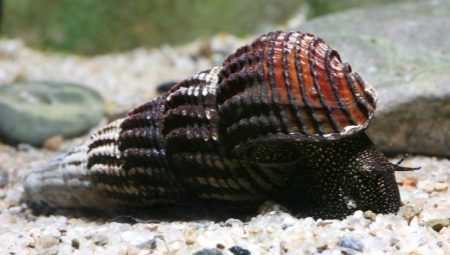Tylomania snail can be the main decoration of a home aquarium. This is a bright clam with an unusual relief of the shell. The structure of the mouth of the snail is quite comical, and this feature of it attracts many lovers of aquariums. The content of this creature is available not only for specialists, but also for beginner aquarists.
Description
The length of the shell of the mollusk is 2-12 cm. In different individuals, the structure of the shell may vary, for example, be smooth or needle-shaped. This unusual creature is known in the circles of aquarists under several names: “Darwin snail”, “orange rabbit”, “orange head”, “snail Tilo”.
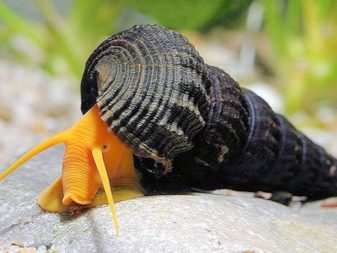

And although most of the names include the word "orange", the body of a snail can be not only this color. There are individuals with cream, black, yellow or white spots, there are species with black torsos and yellow tentacles. Under the tentacles are small eyes. The muzzle is large, and the antennae are long, fold.
In nature, snails live in the waters of Lake Paso and the Malili lakes system, and for the first time this animal became known in 1800. Tylomelania can occur in different shapes and colors, and their appearance is determined by the habitat.
For example, on a rocky terrain, large snails with bright colors and a massive angular body often live.
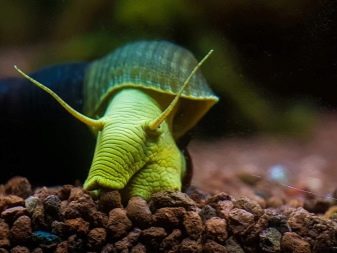
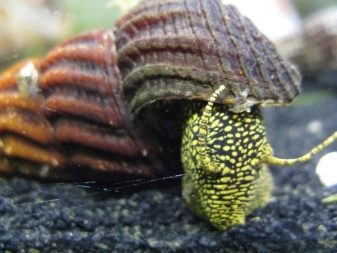
Growing conditions
With the content of tylomelania snail, one individual will need at least 10-15 liters of water. Recommended temperature limits are 27-30 degrees, ideally 28 degrees. It is important to maintain medium hardness. If this parameter is exceeded, the mollusk will become passive and may hibernate, and too soft water will provoke the destruction of the shell.
Before you put the snail in the tank, prepare the soil. Put leaves, driftwood, stones at the bottom, which will remind individuals of natural rocks. The mainsail will allow pets to hide from the bright light that these mollusks cannot tolerate and therefore rarely creep out into the illuminated space. The soil itself, choose sandy or loamy.
Refuse to use gravel, this type of soil will not work tilomelaniya.

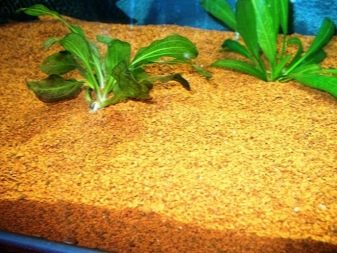
Feeding and care
This interesting creature has an excellent appetite, it is constantly in search of food and from hunger it can even eat algae. Of aquatic plants, they will probably not like moss and cladophore. Well, these snails eat dry food, and also do not mind eating a dead fish. Menu telomelaniya can consist of the following products:
- shrimp
- fish fillet;
- shredded vegetables: cucumbers, zucchini, white cabbage.
Ready-made feeds can be used, but those that settle to the bottom rather than floating on the surface. Spirulina, granules and flakes for catfish and shrimp are suitable, for example. In order for the snail shell to fully develop, it is important to include calcium in the diet.


If tylomelania is kept together with other fish, then it will be able to eat food intended for fish, eat up the waste products of their activity, and clean the aquarium of dead fragments of aquarium plants. That is, this snail may well serve as a biological filter in an artificial reservoir.
If the mollusk eats ready-made fish food, then make sure that it does not contain copper sulfates, since this substance is poisonous to gastropods. Fatal copper can also be found in fertilizers that some aquarists feed aquatic plants. Individuals are fed several times a day, and this is just the case when pets are better to overfeed than not to overfeed. In search of food, a snail can bury itself in the ground.
When taking care of tilomellas, control the operation of the aeration system. These snails need an abundance of oxygen. In addition, it is important to change 1/3 of the volume of the aquarium every week.
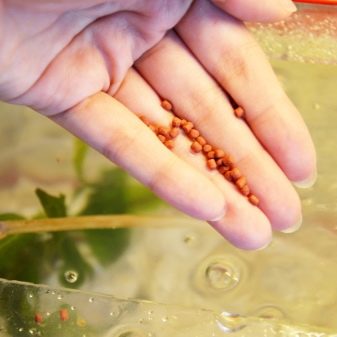
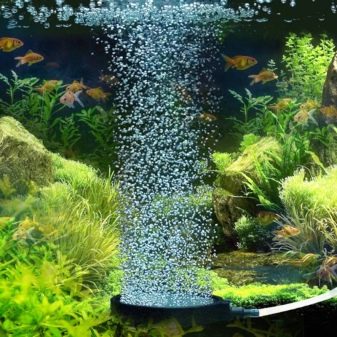
Reproduction and longevity
Unlike many of its relatives, tylomelania snails belong to heterosexual viviparous mollusks. However, it is impossible to distinguish two individuals by gender. Female snails give birth to one baby every 2 months.
The cubs are born in a milk cocoon, which they eat with their mother and other snails so that the baby gets out quickly. Babies are born in the size of 0.3-1.7 cm. They grow quite slowly, only by 8 months the size of the young individual will reach 8 cm. On the whole, the cubs are quite active, they quickly adapt to life in the aquarium, and immediately begin to study the situation.
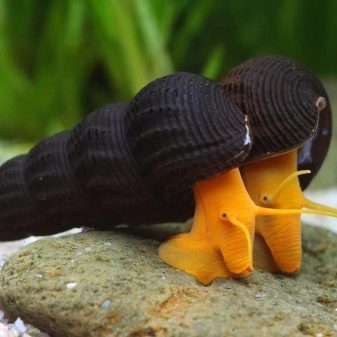
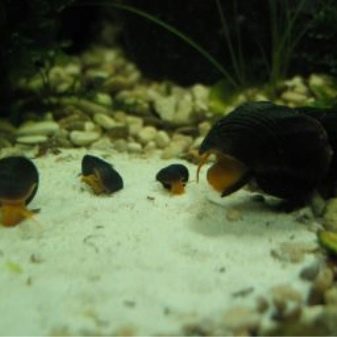
Sometimes these snails give birth only to an empty cocoon, this phenomenon is called shock birth. This happens when there is a sharp change in water or when a new clam is added to the aquarium. Sometimes the shell is not empty, but with an underdeveloped embryo, quite viable.
In general, reproduction in an artificial reservoir is a rather rare occurrence, especially if tylomelania live together with fish. The lifespan of these animals is 1-3 years.
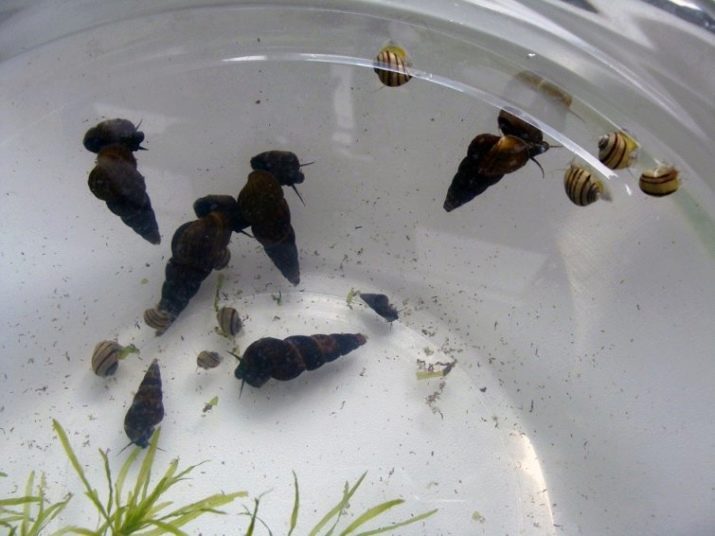
Compatibility
If the individuals are not large, then they get along well with other small snails: coils, ampoules, chalks, and Pokémon. Sulawesky shrimps can be suitable as neighbors - these creatures love to feast on the secret that exudes tilomelaniya.
If the snail is large, it is best not to keep it together with fish and shrimp. If you keep tilomelania with aggressive predatory fish, then they will soon become the prey of the latter.
Tilomelaniya get along well with each other, it is important to keep at least a couple of snails in one container. At the same time, they will well accept the newcomer, crawl to him and get acquainted in a tactile way.If the owner sees that no one shows interest in the new resident, then you should bring the snails to each other and wait until they touch their heads - this ritual will allow the newcomer to get used to the new home faster.
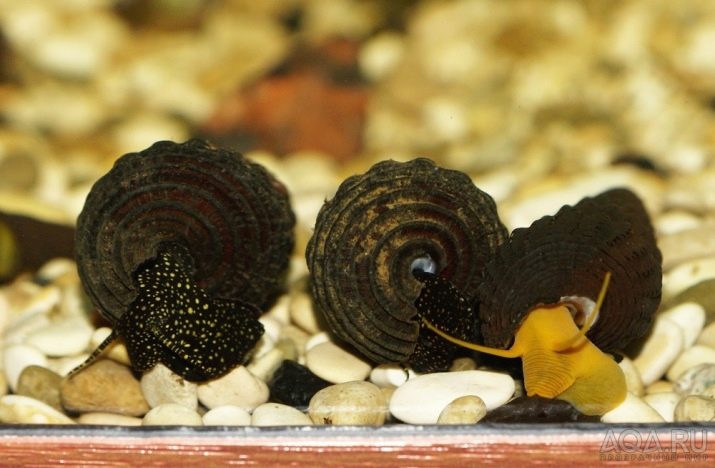
About the features of caring for these snails, see below.
